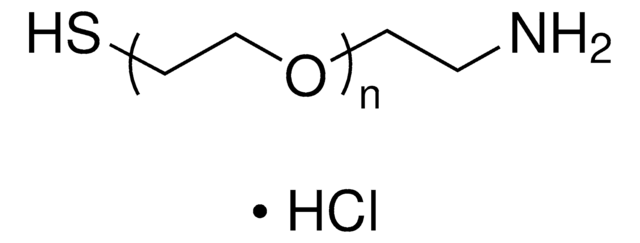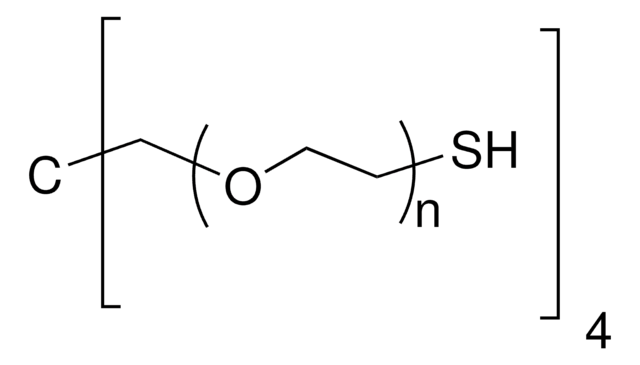729140
Poly(ethylene glycol) methyl ether thiol
average Mn 2,000, chemical modification reagent thiol reactive, methoxy, thiol
Sinônimo(s):
Polyethylene glycol, Methoxy PEG thiol, Methoxypolyethylene glycol thiol, PEG thiol, mPEG thiol
About This Item
Produtos recomendados
product name
Poly(ethylene glycol) methyl ether thiol, average Mn 2,000
forma
solid
peso molecular
average Mn 2,000
adequação da reação
reagent type: chemical modification reagent
reactivity: thiol reactive
pf
50-55 °C
Ω-final
thiol
α-final
methoxy
arquitetura do polímero
shape: linear
functionality: monofunctional
temperatura de armazenamento
−20°C
Procurando produtos similares? Visita Guia de comparação de produtos
Categorias relacionadas
Aplicação
- Surface modification of polyaniline nanorods with thiol-terminated poly (ethylene oxide): This study explores the use of varying molecular weights of poly(ethylene glycol) methyl ether thiol for modifying the surface of polyaniline nanorods, aiming to enhance their dispersibility and functionality (DiTullio et al., 2018).
- Colorimetric determination of p-phenylenediamine using silver nanoparticles modified with poly (ethylene glycol) methyl ether thiol: The research demonstrates the use of poly(ethylene glycol) methyl ether thiol in modifying silver nanoparticles for the colorimetric determination of p-phenylenediamine, showcasing its application in analytical chemistry (Lee et al., 2017).
- Facile synthesis and self-assembly of amphiphilic polydimethylsiloxane with poly (ethylene glycol) moieties via thiol-ene click reaction: This article discusses the synthesis and self-assembly of amphiphilic copolymers using thiol-ene click chemistry, emphasizing the versatility of poly(ethylene glycol) methyl ether thiol in creating functional materials (Xia et al., 2015).
- Determination of polyethylene glycol end group functionalities by combination of selective reactions and characterization by matrix assisted laser desorption/ionization time of flight mass spectrometry (MALDI-TOF MS): This study highlights a method for characterizing end group functionalities of poly(ethylene glycol) derivatives using MALDI-TOF MS, where poly(ethylene glycol) methyl ether thiol plays a critical role in the analysis process (Zhang et al., 2014).
Palavra indicadora
Warning
Frases de perigo
Declarações de precaução
Classificações de perigo
Eye Irrit. 2 - Skin Irrit. 2 - STOT SE 3
Órgãos-alvo
Respiratory system
Código de classe de armazenamento
11 - Combustible Solids
Classe de risco de água (WGK)
WGK 3
Ponto de fulgor (°F)
Not applicable
Ponto de fulgor (°C)
Not applicable
Escolha uma das versões mais recentes:
Já possui este produto?
Encontre a documentação dos produtos que você adquiriu recentemente na biblioteca de documentos.
Os clientes também visualizaram
Artigos
Progress in biotechnology fields such as tissue engineering and drug delivery is accompanied by an increasing demand for diverse functional biomaterials. One class of biomaterials that has been the subject of intense research interest is hydrogels, because they closely mimic the natural environment of cells, both chemically and physically and therefore can be used as support to grow cells. This article specifically discusses poly(ethylene glycol) (PEG) hydrogels, which are good for biological applications because they do not generally elicit an immune response. PEGs offer a readily available, easy to modify polymer for widespread use in hydrogel fabrication, including 2D and 3D scaffold for tissue culture. The degradable linkages also enable a variety of applications for release of therapeutic agents.
Nossa equipe de cientistas tem experiência em todas as áreas de pesquisa, incluindo Life Sciences, ciência de materiais, síntese química, cromatografia, química analítica e muitas outras.
Entre em contato com a assistência técnica












